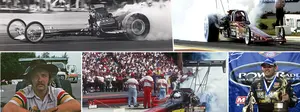

“T.V. Tommy” Ivo and the five-second Top Fuel run that ignited a controversy

Tomorrow, Oct. 22, 2022, will mark the 50th anniversary of the controversial breaking (or not breaking) of one of drag racing’s great barriers. At a match race at Keystone Raceway Park in New Alexandria, Pa., on Oct. 22, 1972, “T.V. Tommy” Ivo received a 5.97 time slip, allowing him to lay claim to the first five-second Top Fuel clocking.
For reasons we’ll discuss later, Ivo’s time was called into question by many, especially in NHRA-centric circles, who tended to bestow the honor upon the late Mike Snively, who ran 5.97 almost four weeks later at the NHRA Supernationals at Ontario Motor Speedway.
Cragar Industries, who founded the Five-Second Club to reward the first 16 drivers to dip into the fives, obviously believed that Ivo’s run was legitimate enough to proclaim him as the first member of the club.
For all practical purposes, the race to the fives began the day that the first six-second pass was recorded which — go figure — is also a bit controversial. John Mulligan was given a 6.95 time slip on Oct. 9, 1966, at Carlsbad Raceway in Southern California for a run in the Adams-Wayre dragster. His next best run that day was 7.27, and he didn’t run another six for almost a year, on Sept. 29, 1967, at Irwindale Raceway, and the fact that the 6.95 run happened after a red-light also cast a lot of skepticism on it.

Most people give Tom McEwen the nod for the first official six, which he recorded May 7, 1967, at an NHRA divisional event at, ironically, Carlsbad. McEwen also ran 7.03 and 7.06 at the event.
Regardless of all that, the race to the fives really began in earnest in early 1972. Low e.t. of 1971 had been a 6.21 by Don Garlits at the Nationals, but 1972 opened with Don Prudhomme and John Wiebe recording spectacular — but also suspicious — dual 6.17s at Lions Dragstrip’s January Grand Premiere (click here for a serious deep dive into those runs). Regardless of the veracity of those runs, the race to the fives was definitely on.

A few weeks later, Clayton Harris made consecutive runs of 6.24, 6.22, 6.28, and 6.27 in Jack McKay’s New Dimension dragster en route to victory at an All-Pro event at Orange County Int'l Raceway, then ran a stunning 6.16 a week later at Lion's.
A few weeks after that, Garlits ran a 6.15 in the semifinals of the Gatornationals and backed it up with a 6.17. A few weeks after that, Harris ran 6.11 at Suffolk Dragway in Virginia, then set the national record at the Division 7 points meet at Lion's Drag Strip in July with a 6.15.
Jerry “the King” Ruth was the first to reach the 6.0s, running 6.065 in round two of the 1972 U.S. Nationals and 6.071 in the quarterfinals. A lot of people figured Ruth would go into the fives in the semifinals or final, but he ran “just” 6.11 in the semi’s then got goaded into a burndown in the final with Gary Beck — a Seattle native trying to dethrone “the King of the Northwest” — and smoked the tires.
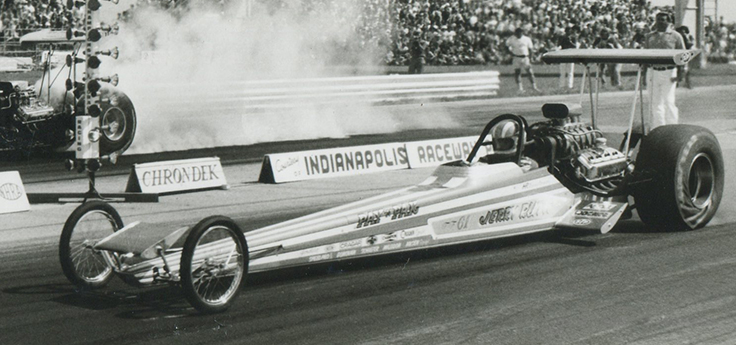
“I knew it would go quicker, and we wanted to be the first five, of course,” Ruth told me last week. “It just surprised me that I did that because I'd been going at it pretty much the same every run. I was going after [the fives], and it just smoked the tires because those cars are always on the verge of tire smoke. We'd get wheel hop and then go into tire smoke.”
With the high-altitude World Finals in Amarillo, Texas, following Indy, all eyes looked beyond that event to the post-season NHRA Supernationals at Ontario Motor Speedway for the chance of the magical first five. Would it be Ruth? Garlits? Harris? Someone else?
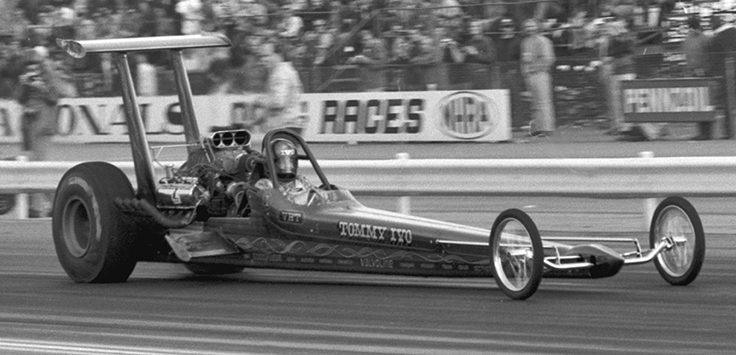
To be honest, Ivo was not even in the discussion as he ran just two national events that year — the Winternationals, where he qualified in the 32nd and final spot and ran a best of 6.84 en route to a second-round loss, and Indy, where he ran a best of 6.35, also in a second-round finish — because he was hitting the match-race trail hard and heavy, running about 100 dates a year. He had won the IHRA Texas Longhorn Nationals in Dallas in June with an IHRA record of 6.25, so the car definitely showed it could run, but it was the only time that whole year he ran that good, so no one had him in their five-second pool.
Keystone Raceway Park in New Alexandria, Pa., was opened in 1968 (and still running today) but wasn’t an NHRA track (and still isn’t) so the spotlight didn’t shine very brightly there back then, which didn’t help burnish the validity of Ivo’s pass.
I don't have any old Drag News copies and can’t find any written record of the day except a one-paragraph recap in John Hogan’s “Behind The Scenes” column in the February 1973 issue of Drag Racing USA.

Ivo’s pass was so much quicker than he had ever run and the track was not that well known, so the run was regarded as being somehow incorrect and not recognized. Ivo had broken barriers before — his twin Buick gas dragster was reported to be the first to 170, 175, and 180 mph and the first in the eights on gasoline — and his 7.99 in late 1962 at Southern California’s San Gabriel Raceway has been legitimized in some places despite it coming more than a year after Connie Swingle was reported to have run 7.88 in Garlits’ car in Blaney Dragstrip in Chester, S.C., because Ivo and tuner Dave Zeuschel ran a slew of high sevens right after and Swingle/Garlits did not. However, one can point to the fact that Swingle’s Swamp Rat III-B was destroyed in a towing accident right after the 7.88, giving them no chance to repeat.

Regardless, Ivo’s pass was met with furrowed brows and scratched heads in some corners, especially on Riverside Drive, where NHRA President Wally Parks — no doubt still smarting from Garlits staging his PRA/AHRA race in Tulsa, Okla., against the Nationals in Indy — probably hated missing out on the publicity coup he was always seeking. No mention of Ivo’s run was made in the Parks-run National Dragster, which weeks later lauded Mike Sniveley’s run at the Supernationals as the first five.
(Flash forward 16 years to 1988 when Eddie Hill made the first four-second run at Texas Motoplex — then under IHRA sanction — and we were allowed to report on the run in National Dragster but had to describe the location as "a track outside of Dallas," which Motorplex owner Billy Meyer humorously had lettered on the rear spoiler of his Funny Car.)
I reached out to Ivo for his memories and take on the whole situation, and he good-naturedly answered my questions despite him thinking perhaps I was out to do a hatchet job on one of his great accomplishments, which I certainly wasn’t. He was open to discussing the skepticism, which he understood completely.
“I don't want to drag dead bodies out again, and the only thing I don't want is for this to be a ‘Karamesines run’ where you run 200 four years ahead of everybody,” he said, referencing perhaps the most contentious broken barrier in drag racing history. “There was a lot of skepticism just because NHRA had said, 'If it doesn’t happen at [an NHRA] national event, it doesn't work,' and they had been kind of accepting of runs that were believable. Maybe this wasn’t to them.”

Whether or not Parks believed it was immaterial because Cragar did, proclaiming Ivo the first member of its Five-Second Club, and Parks even took part in a ceremonial photo with Ivo and Cragar’s Tom Shedden at the Winternationals the following year.

Ed Iskenderian had Pete Millar skewer the whole controversy in one of his Isky Toons ads featuring famed NHRA announcer Bernie Partridge “saying”: “Was it run on one of our strips? Verified by the FIA?” and when the answer was no, saying, "Then we can assume it never happened.” It’s kinda funny/not funny. (You can find the whole collection of creative and hilarious works of Millar for sale here.)

Drag News — "The Drag Racer's Bible" — had no problem believing it, trumpeting it on the front page of its Nov. 4, 1972 issue.
For the record, I can’t find any reference to Cragar or NHRA saying it had to be run at an NHRA national event. Garlits’ first five – a 5.95 the following July which made him the third guy in the club behind Snively and Moody – happened in Portland, Ore., and James Warren (Fremont Raceway), Pete Kalb and Jerry Ruth (Beeline Dragway in Arizona, during the preseason race there), Carl Olson (Bakersfield, during the March Meet), Gary Ritter (Sacramento Raceway), and Frank Bradley (Orange Count Int’l Raceway) also did them at non-national events.
But back to Ivo’s memories …
“I was racing the local, and it pretty much ran away from him, so it was hard to use that for a judgment and, of course, there were no reaction timers in those days, to even see how the leave was,” he said.

“I don't want to stand on a box like Karamesines, but it had all the ingredients and all the possibilities to happen. It started out a very present fall day and warmed up the track nicely, which we coveted a half-century ago. But when we rolled up for the round, a cold front swiftly rolled in — I mean, a cold front; I was afraid it was gonna rain — and gave me that good bump on the horsepower, so, with the warm track, we had good horsepower and good traction, so, the ingredients were there. Even though they didn't prep the tracks in those days, we had all the track prep we needed in a bottle of VHT.” [For the record, Ivo also dismissed the report that he had run 6.03 earlier in the day.]
Ivo recalls that he didn’t even have the chance to celebrate the milestone pass.
“I was out in the woods, and everybody was running because it was just about to rain and put a wet blanket on my parade,” he remembered. “Then again, if we didn't have that [bad weather] happen, it wouldn't work. You can't have your cake and eat it, too.”
Ivo never had the chance to back up the 5.97 — one of the big shadows cast upon the run’s legitimacy — and he only had one race left that year, in Miami, “where the beach was alongside the beach and [sand] made it slippery; you just couldn't go anywhere. After that, I came home and took off for the winter and built two cars for the next year.”
Four weeks after Ivo’s 5.97, the five-second barrier fell at the NHRA SuperNationals at Ontario Motor Speedway. The track was known to be quick, and the weather cooperated, and that the barrier was in jeopardy was evident from the start.
Colorado-based schoolteacher Ed Renck led the field with a 6.09 (but later had to withdraw from the event due to bearing problems). Snively was second at 6.10 and Moody seventh with a 6.22 at just 190 mph.
Moody and crew chief Wes Cerny looked like they would get to the fives first, running a 6.00 in round two and a 6.01 at only 201 mph in the semifinals.
“Between rounds, Wes had upped the blower boost, thus the 6-flat, but it was spinning the tires in the lights,” Moody told me a few years ago. “On the 6.01 run [in the semifinals, against Carl Olson], I shut off early because we had the race won, [and because] we had just spun the tires through the lights, I didn't want to throw all the parts out.”
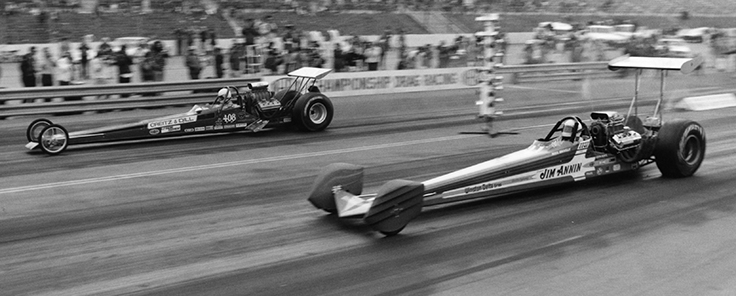
Moody literally twice was milliseconds away from quarter-mile immortality and right behind his early-shutoff 6.01, Snively pounded out a resounding 5.97, 235.69 mph clocking in "Diamond Jim" Annin's new fueler but lost on a holeshot to Vic Brown's 6.03.

The fans were probably still buzzing about Snively's pass when the final round pulled to the line, and no doubt left with their jaws on the ground when Moody screamed to a 5.91 to win the event.

Snively — pictured here accepting the "official" congratulations from Parks at Ontario — of course, is no longer with us, having died just two years later, in 1974, but I talked to both Moody and Ruth for this article, and both graciously supported Ivo’s 5.97 as the first five.
“At the time, I never gave it a thought,” said Moody. “Tom was more an exhibition performer, not a competition seeker, but more power to him, first in the fives is fine with me. At Ontario in 1972, I felt each round we had a tenth on the field. It’s unfortunate that Snively lost in the semi’s or we could have both run fives side by side in the final. Hindsight is just a cliché; I’m OK with how it turned out: ‘T.V. Tom’ was first.”
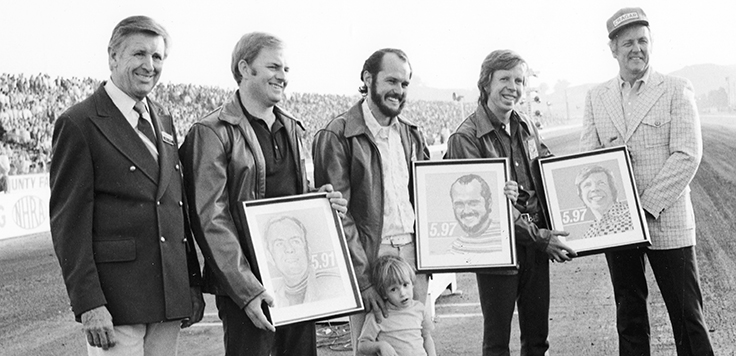
The five-second runs by Moody and Snively were officially acknowledged at the following year's Winternationals in this group photo with Ivo, Parks, and Shedden.
Ruth also had no problem accepting Ivo’s time.
“Ivo was a lot better racer than people remember,” he said. “He built his own cars, built his own engines. He just did a lot of stuff. And not many people give him any kind of credit. They think he's just a movie star, but actually not true. He was very talented.”
And, finally, this from Ivo: “My outlook on it is Garlits had run in the sevens a year before I did because he was jumping the wheels over the starting-line lights, so they called my first seven-second run, ‘The first on the West Coast.’ So, if someone felt they got short-changed with the fives, I think I got short-changed with the sevens.

“I mean, [all of my accomplishments] were all good at their given period of time, but the five-second run meant a lot to me,” he added, “and I got a lot more bookings because of it, not that I wasn’t already busy. I was plenty popular. I was the first one ever to tour, and I was a movie star, and I had a TV series when I went out with my first fuel car. I probably contributed more to drag racing at that period in time. It was my movie background; I knew how to promote myself because I had been showing myself all my life.
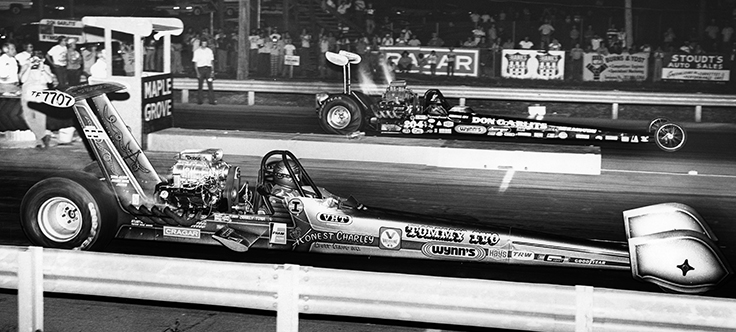
“I had a pretty good deal with this drag racing. I didn't make a whole bunch of money — I made good money with it, but I'm not living in [John] Force’s mansion — but I enjoyed the competition. I never kept count, but we beat Garlits as many times as he beat me. We'd race 50 times a year and beat him as much as he beat me except for the year [1971] that he came out with the rear-engine car and used me for a doormat.
“I enjoyed the mechanics as much if not more than driving, which is why the performance barriers always meant so much to me.”
For the record, here’s the official list of the Cragar Five-Second Club, with Ivo in the No. 1 spot. Did he do it? I can’t say. What do you think?
| Cragar 5-Second Top Fuel Club | ||||
1. |
Tommy Ivo |
Oct. 22, 1972 |
5.97 |
New Alexandria, Pa. |
2. |
Mike Snively |
Nov. 17, 1972 |
5.97 |
Ontario, Calif. |
3. |
Don Moody |
Nov. 17, 1972 |
5.91 |
Ontario, Calif. |
4. |
Don Garlits |
July 7, 1973 |
5.95 |
Portland, Ore. |
5. |
Gary Beck |
Sept. 3, 1973 |
5.96 |
Indianapolis |
6. |
James Warren |
Oct. 13, 1973 |
5.97 |
Fremont, Calif. |
7. |
Larry Dixon Sr. |
Nov. 16, 1973 |
5.94 |
Ontario, Calif. |
8. |
Dan Richins |
Nov. 16, 1973 |
5.93 |
Ontario, Calif. |
9. |
John Stewart |
Nov. 16, 1973 |
5.92 |
Ontario, Calif. |
10. |
Pete Kalb |
Jan. 26, 1974 |
5.96 |
Phoenix |
11. |
Jerry Ruth |
Jan. 27, 1974 |
5.95 |
Phoenix |
12. |
Dwight Salisbury |
Feb. 2, 1974 |
5.97 |
Pomona, Calif. |
13. |
Dwight Hughes |
Feb. 2, 1974 |
5.97 |
Pomona, Calif. |
14 |
Carl Olson |
March 10, 1974 |
5.94 |
Bakersfield, Calif. |
15. |
Gary Ritter |
March 23, 1974 |
5.84 |
Sacramento, Calif. |
16. |
Frank Bradley |
June 29, 1974 |
5.96 |
Irvine, Calif. |
Phil Burgess can be reached at pburgess@nhra.com
Hundreds of more articles like this can be found in the DRAGSTER INSIDER COLUMN ARCHIVE
Or try the Random Dragster Insider story generator



















































